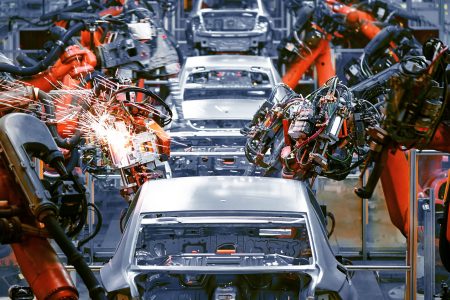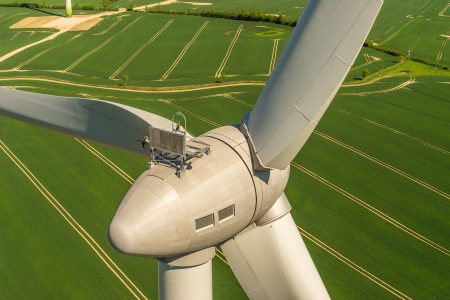Semiconductors in Industry
The 21st century’s most advanced technologies rely on semiconductors. The tiny switches and amplifiers that precisely manage electrical currents that control power, sensors and communication systems, they animate everything from refrigerators to cell phones to satellites.
While the semiconductor industry is characterized by vertical specializations such as design, manufacturing and system integration, they are profoundly horizontal in application. From the chip in your dog’s ear to autonomous vehicles, semiconductors are ubiquitous. From advanced manufacturing, aerospace and defence, agriculture, automotive, medtech, mining and natural resources, oceans to telecommunications – semiconductors are the fundamental building blocks of the technology that powers the economy.

Advanced Manufacturing
Advanced manufacturing techniques use modern technology and processes to make things better, faster, and smarter.
An example is using IoT sensors to collect data for real-time monitoring and optimization – making processes smart. Automation, AI and Robotics are other widely used Advanced Manufacturing techniques.
Semiconductors are critical to Advanced Manufacturing – all of this depends on advanced, specialized chips. Every smart sensor and device relies on semiconductors to:
- Sense what’s going on in the environment (temperature, pressure, etc.)
- Process the data
- Store the information
- Communicate with other devices on the IoT
Semiconductors enable real-time data collection – a pillar of Advanced Manufacturing. Data collection and processing helps manufacturers cut downtime, boost output, reduce waste, and keep workers safe by detecting early signs of equipment wear, stress, or failure.

Aerospace
Aerospace as we know it today would not exist without semiconductors. All modern aircraft from commercial jetliners, military fighters, satellites, and spacecraft rely on avionics – electronic systems used for communication, navigation, monitoring, and control. Semiconductors are the foundation of all those systems.
Navigation and communication systems rely on radar, LIDAR, and satellite communication, all of which use advanced semiconductor technologies to function reliably under harsh conditions.
Cutting-edge craft are backed by power electronics, often using compound semiconductors such as gallium nitride (GaN), to manage electrical loads and energy-intensive functions. Control systems such as flight control computers, stability augmentation systems, and engine controls — all rely heavily on semiconductor-based hardware.

Agriculture
Semiconductors are critical in the entire agri-food value chain, from field to fork. They make smart farming and efficient food systems possible, while helping minimize environmental impacts.
Precision agriculture uses sensor technologies to collect and analyze data on soil health, crop conditions, livestock behaviour, water requirements, and environmental factors such as nitrogen and other emissions.
These sensors empower farmers to optimize water use, enhance fertilizer management, and reduce pesticide dependence. By closely monitoring data in real-time, farmers can optimize yields while minimizing their environmental impact.
Chip technologies are also revolutionizing food safety and quality control. Sensors with embedded chips track food throughout its journey to the table, detecting contaminants, minimizing waste, and optimizing quality.
Semiconductor-based sensors and other technologies throughout the value chain make the agri-food industry more efficient, more sustainable, and more resilient while providing us with safer, high-quality food.

Automotive
Electric vehicles (EVs) are an important step to decarbonize transportation, a sector responsible for significant greenhouse gas emissions. Electric vehicles run on electricity stored in batteries, but to actually use that power, the vehicle needs to convert it and control that energy. Semiconductors are necessary for this critical step.
Semiconductors convert electricity stored in the battery power into power that can be used by the motor(s), manage charging, and control voltage levels between the battery and different parts of the car.
Without semiconductors, the car wouldn’t be able to move at all, or charge efficiently.
All modern vehicles are integrating semiconductor-based sensors to optimize efficiency and improve safety, but EVs need semiconductors for their most basic functionality.

Clean Tech and Energy
Semiconductors are enabling the clean energy revolution, allowing us to move towards a more sustainable, cost-effective, and energy-efficient future.
Solar Power requires power electronics and semiconductors to manage the conversion energy from solar panel to the grid. These electronics improve efficiency, reduce energy loss, and stabilize power flow for safety.
in wind turbines, semiconductors optimize efficiency, regulate speed, and convert energy from the wind into electricity. High-performance power semiconductor devices ensure minimal energy loss, especially in harsh conditions. Power electronics and semiconductors are required to handle high voltages and currents to make them ready for the grid.
As power grids come under increasing strain, smart grids use semiconductor-powered sensors, meters, and communication systems to efficiently distribute electricity while keeping grids stable.
Compound semiconductor technology is an area where Canadian firms excel – and is a core technology targeted by FABrIC. Compound semiconductors (such as SiC and GaN) are transforming clean tech, especially in power conversion and energy management, making clean energy more reliable and affordable.

Digital Technologies &Telecommunications
Digital technologies capture, process, share, and act on digital data. Examples include like computing, connectivity, and data analytics – including AI. Semiconductors are the foundation that makes all of this possible.
Without semiconductors, there is no computing power, no wireless connections, no smart systems or IoT sensors. Semiconductors are critical to the pillars of our digital lives and modern economy.

Future Natural Resources
Future natural resources are the increasingly valuable materials and energy sources that will play a critical role in our digital lives and economy. As the world moves toward clean tech, electrification of transportation, automation, and other transformational shifts, our need for these resources will grow significantly. Examples include Lithium, Cobalt, Graphite, and Nickel for batteries and battery components, Rare Earth Elements for everything from EV drivetrains, wind turbines, and digital displays of all kinds, Gallium, and Germanium for compound semiconductors and solar panels solar panels.
IoT sensors are critical in the mining industry. Autonomous vehicles rely on smart sensors and connectivity for all their functionality, while sensors constantly monitor air quality, and ground stability to keep workers safe.

Medtech
Modern healthcare solutions rely on electronic devices for diagnostics, imaging, and monitoring, all which runs on semiconductor technology.
From hospital-grade technologies running on semiconductor-based technologies such as robotic surgery platforms, ECG/EEG monitors, heart rate sensors, and biosignal measurement devices, to image sensor chips are used in all cameras for diagnostics, miniaturized surgical tools, and pill cameras, semiconductors make cutting-edge healthcare possible.
Connected wearables provide healthcare providers with real-time data and empower patients to take control of their healthcare.
Every medtech device from the most advanced to the most accessible needs semiconductors to sense, process, and store, and communicate health data safely and reliably.

Oceans
Modern vessels rely on complex electronic systems powered by semiconductors. Largely impervious to harsh marine environments, navigation, communication devices, engine control units, sonar technology and monitoring mechanisms all leverage semiconductor technology’s ability to process information efficiently and accurately.
Smart shipping and ports; sustainable aquaculture, oceanographic research, coastal surveillance and security, oceanic infrastructure and energy use as well as marine wildlife all rely on the processing capabilities of semiconductors.
